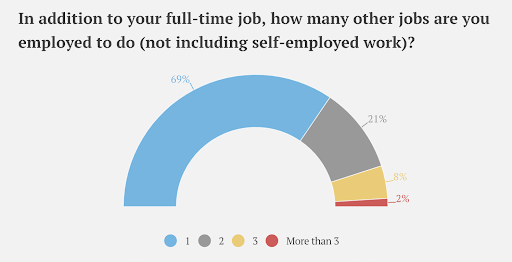
Everyone has a mental image that comes to mind when they think of a gig worker, from a delivery driver to a freelancer taking on a company’s side projects. But when navigating this evolving work landscape, the gig marketplace may expand to include new industries, roles, and workers. This is why ensuring a company is prepared for this potential transformation in the working world is essential.
Read on to explore what’s changing and learn how to update recruitment practices to welcome this new kind of worker.
Over the past decade, gig workers were mainly viewed as shift workers. Traditionally, it referred to short-term or freelance work, such as rideshare drivers, dog walkers, graphic designers, and copywriters.
Gig jobs have been around for a while, but the pandemic played a crucial role in elevating their popularity. With the continuous disruptions in the hiring landscape, many organizations were forced to adopt new work arrangements. Gig jobs emerged as a viable alternative for many individuals seeking employment opportunities. Gig work then shifted to include project-based work, which many companies have taken advantage of in recent years.
Now, the gig marketplace encompasses a much wider range of jobs and work arrangements, gaining significant traction among younger generations. An increasing number of individuals are seeking work arrangements that provide them with flexibility and the ability to choose their jobs and schedules. Since many of these roles can be remote (such as those with graphic design or digital marketing specialist roles), workers can choose when, where, and what they take on.
However, as companies continue to grow and expand their workforce, job seekers are also doing the same: but exploring other opportunities to join the workforce, while keeping their current role.
The gig economy's rapid growth provides numerous options for modern workers to earn from various sources. The capacity to work multiple gigs simultaneously empowers workers to increase their earnings substantially. As of recent, this also includes people who are juggling multiple full-time jobs. For example, some workers have two W-2’s with two salaries – at the same time. According to Resume Builder, one in five remote workers have at least two full-time jobs, with 37% earning themselves an additional $100,000 per year.

Source: Resume Builder
With the emergence of this new type of worker in the workforce, it appears that the definition of gig work should be broadened to include them. They’ve even coined the term “overemployed” in a Reddit community.
With many companies not forcing workers to come back into the office (which historically has been challenging to do, with flexible working on the rise), many companies are updating work practices to align with the needs and desires of their employees, which in turn helps with retention. This makes it attractive and attainable for gig workers to seek other work opportunities to fill their time during the day.
With the recent wave of layoffs, there has also been a significant surge in entrepreneurship applications and new businesses being created. As a result, individuals who operate as one-person armies, equipped with technology (such as ChatGBT and other AI tools) can accomplish a great deal.
This kind of gig worker most likely has no incentive to take on more work in their current role. To elaborate, if their calendars are not filled up during their 9-5, workers have no motive to take on additional work from the organization – since there are no bonuses or extra compensation to encourage them to do so. If that’s the case, if these workers have free time during their workday, they may decide to work for another company – especially since non-compete agreements are becoming less prevalent.
For those workers, once they achieve their key performance indicators (KPIs) and are able to make sure their performance doesn’t slip, they are enticed with the idea of seeking other employment opportunities. This is becoming prevalent if deliverables are project-based, since there's nothing preventing workers from utilizing AI to finish their tasks – thus freeing up their time to work on another job.
“Companies would need to decide whether they care, because if someone’s doing the job well enough, does it matter that they’re doing other roles?” asked Beth Hale, a partner at law firm CM Murray LLP who specializes in employment law, “If a company has employed someone because they think they’re brilliant and want exclusivity over their skills, they need to decide where they stand on a case-by-case approach.”

As long as employees are fulfilling their contractual obligations, they are not breaking any laws. From the job seeker's perspective, they are exercising their right to choose and fulfill their contracted hours and obligations. Anything beyond that is their personal decision.
If employers are concerned about this gig worker, they should reflect on what may drive someone to seek multiple jobs. The use of gig work as a way to earn extra income is common, so it's understandable that this trend has also extended to corporate positions. Factors such as inflation and expecting employees to do the work of multiple roles without additional compensation could lead to employees seeking bonus roles.
It's crucial to avoid portraying the overemployed trend negatively. If companies respond negatively, it could deter talent from considering a position, regardless of if they are overemployed themselves. It can send a negative message to employees and prospective candidates, which can affect the company’s reputation and create an unintended image they are not seeking.
It’s essential for hiring professionals to know that this is happening and accommodate recruitment practices to meet the needs of their current workforce.
The first step companies should take is to understand their benefits and incentives and ensure they are showcased internally and externally. Job advertising and messaging must also be updated so companies can attract top talent, regardless of their situation. Hiring professionals should seek to update their content, such as job postings, to connect to all top talent – rather than relying on outdated methods that may not resonate with these prospective candidates.
On the other hand, if this sector of gig workers is not ideal for a company, ensure that employer branding and employee value proposition (EVP) reflect that. Foster such a strong EB and EVP that employees and candidates alike feel secure enough that they do not need to look elsewhere for support, growth, or supplemental income. Also, showcasing these may even persuade employees and candidates not to seek other opportunities – if all the benefits and incentives they seek are present. By taking the time to research and understand the target audience a company is seeking, hiring professionals can meet the candidate’s specific needs and preferences they’re looking for with an employer.
Either way, hiring professionals need to ensure their messaging and content are clear about the expectations of their team and what their benefits will be while working at an organization.

As mentioned above, companies should look into their employer brand and EVP, especially in this competitive job market. To effectively communicate with potential employees, it's crucial to understand their unique perspectives and values, so hiring professionals can demonstrate how the company aligns with their beliefs and needs. This approach is helpful for individuals who work in multiple roles or professions.
If companies are looking to be open to this sector of gig workers, employers should review, audit, and update their employer brand and recruitment initiatives to include them. Hiring professionals can leverage these gig workers by positioning the employer brand as being supportive of entrepreneurs, innovative thinkers, and savvy businesspeople. Highlight how the company is open to keeping top talent on board – even if they pursue other ventures.
Ensure all messaging is updated to be inclusive of all talent so candidates feel welcome to apply. Recruiters never know who this might attract – it might be the team's next top performer!
It’s essential to keep in mind that the EVP is the give-get for a company. By providing great incentives, companies can attract and retain the best talent. However, this requires the company to provide the best incentives in the market to keep the talent onboard. It can be challenging to achieve this since job seekers seek different benefits when looking for employment, so companies need to ensure their incentives are enticing for top talent when seeking work opportunities. Understanding their motivations and priorities can help hiring professionals offer incentives and benefits that cater to their needs and ultimately help a company attract talent.
Tip: Surveys can help check the pulse of the employees to see what they are seeking and allow the company to cater incentives as much as possible.
Moreover, companies can unlock a new group in the workforce that they haven't even considered – which can be a great thing! Not only will the company obtain the best talent, but employees will also be more satisfied in their roles (especially if they feel more financially secure and valued).
—-
It might be unconventional even to consider a worker like this. Still, in this labor market, obtaining top talent is essential. It probably won’t be common for companies to find out about their candidate or employee working elsewhere. A company might already have an overemployed person on their team and not even know because their performance never waivers!
Keep up-to-date on trends such as this by connecting with the team at Recruitcs. Our team of industry experts is here to help foster a compelling, inspiring, and unique employer brand and EVP to attract, hire, and retain top talent.
info@recruitics.com
230 East Avenue
Suite 101
Norwalk, CT 06855
US +1 877 410 8004
© 2024 Recruitics • All Rights Reserved


